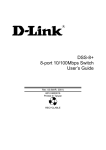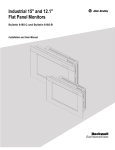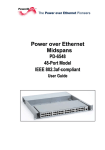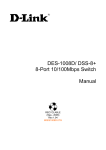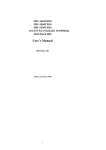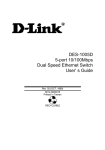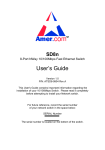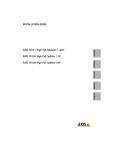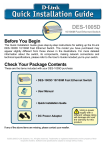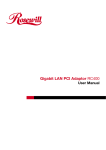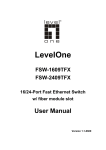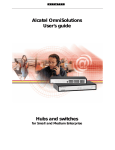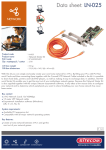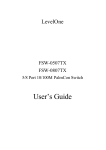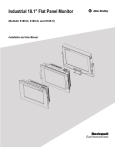Download D-Link DES-1008D
Transcript
DES-1008D 8-Port 10/100Mbps Dual Speed Ethernet Switch User’s Guide Rev. 02 (Mar. 2000) 6012-9600011 Printed In Taiwan RECYCLABLE i LIMITED WARRANTY D-Link Systems, Inc. (“D-Link”) provides this limited warranty for its product only to the person or entity who originally purchased the product from D-Link or its authorized reseller or distributor. Limited Hardware Warranty: D-Link warrants that the hardware portion of the D-Link products described below (“Hardware”) will be free from material defects in workmanship and materials from the date of original retail purchase of the Hardware, for the period set forth below applicable to the product type (“Warranty Period”) if the Hardware is used and serviced in accordance with applicable documentation; provided that a completed Registration Card is returned to an Authorized D-Link Service Office within ninety (90) days after the date of original retail purchase of the Hardware. If a completed Registration Card is not received by an authorized D-Link Service Office within such ninety (90) period, then the Warranty Period shall be ninety (90) days from the date of purchase. Product Type Warranty Period Product (excluding power supplies and fans), if purchased and delivered in the fifty (50) United States, or the District of Columbia (“USA”) As long as the original purchaser still owns the product Product purchased or delivered outside the USA One (1) Year Power Supplies and Fans One (1) Year Spare parts and spare kits Ninety (90) days D-Link’s sole obligation shall be to repair or replace the defective Hardware at no charge to the original owner. Such repair or replacement will be rendered by D-Link at an Authorized D-Link Service Office. The replacement Hardware need not be new or of an identical make, model or part; D-Link may in its discretion may replace the defective Hardware (or any part thereof) with any reconditioned product that D-Link reasonably determines is substantially equivalent (or superior) in all material respects to the defective Hardware. The Warranty Period shall extend for an additional ninety (90) days after any repaired or replaced Hardware is delivered. If a material defect is incapable of correction, or if D-Link determines in its sole discretion that it is not practical to repair or replace the defective Hardware, the price paid by the original purchaser for the defective Hardware will be refunded by D-Link upon return to D-Link of the defective Hardware. All Hardware (or part thereof) that is replaced by DLink, or for which the purchase price is refunded, shall become the property of D-Link upon replacement or refund. Limited Software Warranty: D-Link warrants that the software portion of the product (“Software”) will substantially conform to D-Link’s then current functional specifications for the Software, as set forth in the applicable documentation, from the date of original delivery of the Software for a period of ninety (90) days (“Warranty Period”), if the Software is properly installed on approved hardware and operated as contemplated in its documentation. D-Link further warrants that, during the Warranty Period, the magnetic media on which D-Link delivers the Software will be free of physical defects. D-Link’s sole obligation shall be to replace the nonconforming Software (or defective media) with software that substantially conforms to D-Link’s functional specifications for the Software. Except as otherwise agreed by D-Link in writing, the replacement Software is provided only to the original licensee, and is subject to the terms and conditions of the license granted by D-Link for the Software. The Warranty Period shall extend for an additional ninety (90) days after any replacement Software is delivered. If a material non-conformance is incapable of correction, or if D-Link determines in its sole discretion that it is not practical to replace the non-conforming Software, the price paid by the original licensee for the non-conforming Software will be refunded by DLink; provided that the non-conforming Software (and all copies thereof) is first returned to D-Link. The license granted respecting any Software for which a refund is given automatically terminates. What You Must Do For Warranty Service: Registration Card. The Registration Card provided at the back of this manual must be completed and returned to an Authorized D-Link Service Office for each D-Link product within ninety (90) days after the product is purchased and/or licensed. The addresses/telephone/fax list of the nearest Authorized D-Link Service Office is provided in the back of this manual. FAILURE TO PROPERLY COMPLETE AND TIMELY RETURN THE iii REGISTRATION CARD MAY AFFECT THE WARRANTY FOR THIS PRODUCT. Submitting A Claim. Any claim under this limited warranty must be submitted in writing before the end of the Warranty Period to an Authorized D-Link Service Office. The claim must include a written description of the Hardware defect or Software nonconformance in sufficient detail to allow DLink to confirm the same. The original product owner must obtain a Return Material Authorization (RMA) number from the Authorized D-Link Service Office and, if requested, provide written proof of purchase of the product (such as a copy of the dated purchase invoice for the product) before the warranty service is provided. After an RMA number is issued, the defective product must be packaged securely in the original or other suitable shipping package to ensure that it will not be damaged in transit, and the RMA number must be prominently marked on the outside of the package. The packaged product shall be insured and shipped to D-Link, 53 Discovery Drive, Irvine CA 92618, with all shipping costs prepaid. D-Link may reject or return any product that is not packaged and shipped in strict compliance with the foregoing requirements, or for which an RMA number is not visible from the outside of the package. The product owner agrees to pay D-Link’s reasonable handling and return shipping charges for any product that is not packaged and shipped in accordance with the foregoing requirements, or that is determined by D-Link not to be defective or non-conforming. What Is Not Covered: This limited warranty provided by D-Link does not cover: Products that have been subjected to abuse, accident, alteration, modification, tampering, negligence, misuse, faulty installation, lack of reasonable care, repair or service in any way that is not contemplated in the documentation for the product, or if the model or serial number has been altered, tampered with, defaced or removed; Initial installation, installation and removal of the product for repair, and shipping costs; Operational adjustments covered in the operating manual for the product, and normal maintenance; Damage that occurs in shipment, due to act of God, failures due to power surge, and cosmetic damage; and Any hardware, software, firmware or other products or services provided by anyone other tha n D-Link. Disclaimer of Other Warranties: EXCEPT FOR THE LIMITED WARRANTY SPECIFIED HEREIN, THE PRODUCT IS PROVIDED “ASIS” WITHOUT ANY WARRANTY OF ANY KIND INCLUDING, WITHOUT LIMITATION, ANY WARRANTY OF MERCHANTABILITY, FITNESS FOR A PARTICULAR PURPOSE AND NON-INFRINGEMENT. IF ANY IMPLIED WARRANTY CANNOT BE DISCLAIMED IN ANY TERRITORY WHERE A PRODUCT IS SOLD, THE DURATION OF SUCH IMPLIED WARRANTY SHALL BE LIMITED TO NINETY (90) DAYS. EXCEPT AS EXPRESSLY COVERED UNDER THE LIMITED WARRANTY PROVIDED HEREIN, THE ENTIRE RISK AS TO THE QUALITY, SELECTION AND PERFORMANCE OF THE PRODUCT IS WITH THE PURCHASER OF THE PRODUCT. Limitation of Liability: TO THE MAXIMUM EXTENT PERMITTED BY LAW, D-LINK IS NOT LIABLE UNDER ANY CONTRACT, NEGLIGENCE, STRICT LIABILITY OR OTHER LEGAL OR EQUITABLE THEORY FOR ANY LOSS OF USE OF THE PRODUCT, INCONVENIENCE OR DAMAGES OF ANY CHARACTER, WHETHER DIRECT, SPECIAL, INCIDENTAL OR CONSEQUENTIAL (INCLUDING, BUT NOT LIMITED TO, DAMAGES FOR LOSS OF GOODWILL, WORK STOPPAGE, COMPUTER FAILURE OR MALFUNCTION, LOSS OF INFORMATION OR DATA CONTAINED IN, STORED ON, OR INTEGRATED WITH ANY PRODUCT RETURNED TO D-LINK FOR WARRANTY SERVICE) RESULTING FROM THE USE OF THE PRODUCT, RELATING TO WARRANTY SERVICE, OR ARISING OUT OF ANY BREACH OF THIS LIMITED WARRANTY, EVEN IF DLINK HAS BEEN ADVISED OF THE POSSIBILITY OF SUCH DAMAGES. THE SOLE REMEDY FOR A BREACH OF THE FOREGOING LIMITED WARRANTY IS REPAIR, REPLACEMENT OR REFUND OF THE DEFECTIVE OR NON-CONFORMING PRODUCT. GOVERNING LAW: This Limited Warranty shall be governed by the laws of the state of California. Some states do not allow exclusion or limitation of incidental or consequential damages, or limitations on how long an implied warranty lasts, so the foregoing limitations and exclusions may not apply. This limited warranty provides v specific legal rights and the product owner may also have other rights which vary from state to state. FCC Warning This equipment has been tested and found to comply with the regulations for a Class B digital device, pursuant to Part 15 of the FCC Rules. These limits are designed to provide reasonable protection against harmful interference when the equipment is operated in a commercial environment. This equipment generates, uses, and can radiate radio frequency energy and, if not installed and used in accordance with this user’s guide, may cause harmful interference to radio communications. Operation of this equipment in a residential area is likely to cause harmful interference, in which case the user will be required to correct the interference at his own expense. CE Mark Warning This is a Class B product. In a domestic environment, this product may cause radio interference, in which case the user may be required to take adequate measures. VCCI Mark Warning vii TABLE OF C ONTENTS ABOUT THIS GUIDE........................................................................1 P URPOSE ..............................................................................................1 OVERVIEW OF THIS USER’S GUIDE ...........................................................1 INTRODUCTION ..............................................................................2 FAST ETHERNET T ECHNOLOGY ................................................................2 SWITCHING T ECHNOLOGY .......................................................................2 FEATURES ............................................................................................4 UNPACKING ..........................................................................................6 SETUP ..................................................................................................6 IDENTIFYING EXTERNAL COMPONENTS...............................7 FRONT P ANEL .......................................................................................7 LED I NDICATORS ..................................................................................7 REAR P ANEL .........................................................................................8 CONNECTING THE DES -1008D...................................................10 PC TO DES-1008D..............................................................................10 HUB TO DES-1008D............................................................................10 A. 10BASE-T Hub............................................................................11 B. 100BASE-TX Hub........................................................................11 HUB WITHOUT UPLINK (MDI-II) PORT....................................................11 A. Using straight cable.....................................................................11 B. Using crossover cable..................................................................11 DES-1008D TO SWITCH (OTHER DEVICES)...............................................11 A. Using straight cable.....................................................................12 B. Using crossover cable..................................................................12 P ORT SPEED & DUPLEX MODE ..............................................................12 RJ-45 PIN SPECIFICATION..........................................................13 TECHNICAL SPECIFICATIONS .................................................15 A BOUT T HIS G U I D E Congratulations on your purchase of the DES-1008D. This device integrates 100Mbps Fast Ethernet and 10Mbps Ethernet network capabilities in a highly flexible desktop package. Purpose The purpose of this manual is to show you how to install and configure your DES-1008D. Overview of this User’s Guide ? Chapter 1, Introduction. Describes the DES-1008D and its features. ? Chapter 2, Unpacking and Setup. Helps you get started with the basic installation of the DES-1008D. ? Chapter 3, Identifying External Components. Describes the front panel, rear panel and LED indicators of the DES-1008D. ? Chapter 4, Connecting the DES-1008D. Tells how you can connect the DES-1008D to your Ethernet network. ? Appendix A, Technical Specifications. Lists the technical (general, physical and environmental, and performance) specifications of the DES-1008D. ? Appendix B, RJ-45 Pin Specification. Describes the RJ-45 receptacle/connector and the straight and crossover cable connector. 1 h IN T R O D U C T I O N This chapter describes the features of the DES-1008D and some background information about Ethernet/Fast Ethernet switching technology. Fast Ethernet Technology The growing importance of LANs and the increasing complexity of desktop computing applications are fueling the need for high performance networks. A number of high-speed LAN technologies have been proposed to provide greater bandwidth and improve client/server response times. Among them, 100BASE-T (Fast Ethernet) provides a non-disruptive, smooth evolution from the current 10BASE-T technology. The non-disruptive and smooth evolution nature, and the dominating potential market base, virtually guarantee cost effective and high performance Fast Ethernet solutions in the years to come. 100Mbps Fast Ethernet is a new standard specified by the IEEE 802.3 LAN committee. It is an extension of the 10Mbps Ethernet standard with the ability to transmit and receive data at 100Mbps, while maintaining the CSMA/CD Ethernet protocol. Since the 100Mbps Fast Ethernet is compatible with all other 10Mbps Ethernet environments, it provides a straightforward upgrade and takes advantage of the existing investment in hardware, software, and personnel training. Switching Technology Another approach to pushing beyond the limits of Ethernet technology is the development of switching technology. A switch bridges 2 Ethernet packets at the MAC address level of the Ethernet protocol transmitting among connected Ethernet or Fast Ethernet LAN segments. Switching is a cost-effective way of increasing the total network capacity available to users on a local area network. A switch increases capacity and decreases network loading by dividing a local area network into different segments, which don’t compete with each other for network transmission capacity. The DES-1008D acts as a high-speed selective bridge between the individual segments. The DES-1008D, without interfering with any other segments, automatically forwards traffic that needs to go from one segment to another. By doing this the total network capacity is multiplied, while still maintaining the same network cabling and adapter cards. For Fast Ethernet networks, a DES-1008D is an effective way of eliminating problems of chaining hubs beyond the “two-repeater limit.” A DES-1008D can be used to split parts of the network into different collision domains, making it possible to expand your Fast Ethernet network beyond the 205-meter network diameter limit for 100BASE-TX networks. DES-1008Ds supporting both traditional 10Mbps Ethernet and 100Mbps Fast Ethernet are also ideal for bridging between the existing 10Mbps networks and the new 100Mbps networks. Switching LAN technology is a marked improvement over the previous generation of network bridges, which were characterized by higher latencies. Routers have also been used to segment local area networks, but the cost of a router, the setup and maintenance required make routers relatively impractical. Today switches are an ideal solution to most kinds of local area network congestion problems. 3 h Features The DES-1008D was designed for easy installation and high performance in an environment where traffic on the network and the number of users increase continuously. The DES-1008D with its small, compact size was specifically designed for small to middle workgroups. The DES-1008D can be installed where space is limited; moreover, the DES-1008D provides immediate access to a rapidly growing network through a wide range of functions. The DES-1008D is ideal for deployment with multiple high-speed servers for shared bandwidth 10Mbps or 100Mbps workgroups. With the highest bandwidth 200Mbps (100Mbps full-duplex mode), any port can provide workstations with a congestion-free data pipe for simultaneous access to the server. The DES-1008D is expandable by cascading two or more DES1008Ds together. As all ports support 200Mbps, the DES-1008D can be cascaded from any port and to any number of DES-1008Ds. The DES-1008D is a perfect choice for sites planning to upgrade to Fast Ethernet in the future. Ethernet workgroups can connect to the DES-1008D now, and you can change adapters and hubs anytime later without needing to change the DES-1008Ds or reconfigure the network. The DES-1008D combines dynamic memory allocation with storeand-forward switching to ensure that the buffer is effectively allocated for each port, while controlling the data flow between the transmit and receive nodes to guarantee against all possible packet loss. The DES-1008D is a managed 10/100 Fast Ethernet switch that offers solutions in accelerating small Ethernet workgroup bandwidth. Other key features are: 4 ?? Uplink/ MDI-II (media dependent interface) port for uplink to another switch, hub or repeater. ?? Store and forward switching scheme capability. As the result of complete frame checking and error frame filtering, this scheme prevents error packages from transmitting among segments. ?? NWay Auto-negotiation for any port. This allows for autosensing of speed (10/100Mbps) thereby providing you with automatic and flexible solutions in your network connections. ?? Flow control for any port. This minimizes dropped packets by sending out collision signals when the port’s receiving buffer is full. Note that flow control is only available in half duplex mode. ?? Data forwarding rate per port is at wire-speed for 100Mbps speed. ?? Data forwarding rate per port is at wire-speed for 10Mbps speed. ?? Data filtering rate eliminates all error packets, runts, etc., per port at wire-speed for 100Mbps speed. ?? Data filtering rate eliminates all error packets, runts, etc., per port at wire-speed for 10Mbps speed. ?? 8K MAC address entries table per device for the DES-1008D. ?? 256 KB RAM buffer per device for the DES-1008D. ?? Network looped detecting. 5 h Unpacking and Setup This chapter provides unpacking and setup information for the DES-1008D. Unpacking Open the box and carefully unpacks its contents. The box should contain the following items: ? One DES-1008D ? One external power adapter ? This User’s Guide. If any item is found missing or damaged, please contact your local reseller for replacement. Setup The setup for the DES-1008D can be performed using the following steps: ?? The surface must support at least 1.5 Kg for the DES-1008D. ?? The power outlet should be within 1.82 meters (6 feet) of the DES-1008D. ?? Visually inspect the DC power jack and make sure that it is fully secured to the power adapter. ?? Make sure that there is proper heat dissipation from and adequate ventilation around the DES-1008D. Do not place heavy objects on the DES-1008D. 6 IDENTIFYING E XTERNAL C OMPONENTS This section identifies all the major external components of the DES-1008D. Both the front and rear panels are shown followed by a description of each panel feature. The indicator panel is described in detail in the next chapter. Front Panel The figure below shows the front panel of the DES-1008D. ? LED Indicator Panel Refer to the LED Indicator section for detailed information about each of the DES-1008D’s LED indicators. LED Indicators Power Indicator (PWR) This indicator lights green when the hub is receiving power, otherwise, it is off. Loop Detect (LOOP) When this indicator lights amber, it means that there is a loop detected, then the network needs to be re-configuration. 7 h Full-Duplex/Collision (Full-Duplex/Collision) This LED indicator lights green when a respective port is in full duplex (FDX) mode. Otherwise, it is blinking when collisions are occurring on the respective port. 100M Link/Activity, 10M Link/Activity (100M LINK/ACT (green), 10LINK/ACT(amber)) This indicator lights green when the port is connected to a 100Mbps Fast Ethernet station, if the indicator blinking green will be transmission or received data on the 100Mbps network. Otherwise, if the indicator light amber when the port is connected to a 10Mbps Ethernet station, if the indicator blinking amber will be transmission or received data on the 10Mbps network. Rear Panel ? DC Power Jack: Power is supplied through an external AC power adapter. Check the technical specification section for information about the AC power input voltage. Since the DES-1008D does not include a power switch, plugging its power adapter into a power outlet will immediately power it on. 8 ? MDI-X Jacks: Use these jacks to connect stations to the hub. These are MDI-X (Medium-Dependent Interface, Cross-wired) jacks, which mean, you can use ordinary straight-through twisted-pair cables to connect user machines and servers to the hub through them. If you need to connect another device with an MDI-X jack, such as another hub or an Ethernet switch, you should use a crossover cable, or make the connection using the MDI-X jack (described below). ? Uplink Jack(s) (MDI-II): Use this jack to connect stations to the hub. This is an MDI-II (Medium-dependent Interface, straightwired) jack, which means you can connect the hub to a device with an MDI-X port using an ordinary straight-through cable, making a crossover cable unnecessary. 9 h C ONNECTING T HE DES-1008D This chapter describes how to connect the DES-1008D to your Fast Ethernet network. In each of the following figures, the DES-1008D is shown. PC to DES-1008D A PC can be connected to DES-1008D via a two-pair Category 3, 4, 5 UTP/STP straight cable. The PC (equipped with a RJ-45 10/100Mbps phone jack) can be connected to any of the 8 ports (1x - 8x). The LED indicators for PC connection depend on the LAN card’s capabilities. If LED indicators are not lit after making a proper connection, check the PC LAN card, the cable and the DES-1008D conditions and connections. The following are LED indicator possibilities for a PC to DES-1008D connection: 1. The “100LINK/ACT,10LINK/ACT” LED indicator lights green for hookup to 100Mbps speed or light amber for hookup to 10Mbps speed. 2. The “Full-Duplex/Collision” LED indicator depends upon LAN card capabilities for full duplex or half duplex. Hub to DES-1008D A hub (10 or 100BASE-TX) can be connected to the DES-1008D via a two-pair Category 3, 4, 5 UTP/STP straight cables. The connection is accomplished from the hub uplink (MDI-II) port to any of the DES1008D (MDI-X) ports: 1x - 8x for the DES-1008D. 10 A. 10BASE-T Hub For a 10BASE-T hub, the DES-1008D LED indicators should light up as the following: “Full-Duplex/Collision” indicator is OFF. “100LINK/ACT,10LINK/ACT LED” indicator is light amber. B. 100BASE-TX Hub For a 100BASE-TX hub, the DES-1008D LED indicators should light up as the following: “Full-Duplex/Collision” LED indicator is OFF. “100LINK/ACT,10LINK/ACT” LED indicator is light green. Hub without Uplink (MDI-II) port If a hub is not equipped with an uplink (M DI-II) port, connection can be made using either straight cable or crossover cable. A. Using straight cable When using straight cable, the connection can be made from the uplink (MDI-II) port of the DES-1008D to any port of the hub. B. Using crossover cable When using crossover cable, the connection can be made from any (MDI-X) ports of the DES-1008D to any port of the Hub. DES-1008D to switch (other devices) The DES-1008D can be connected to another switch or other devices (routers, bridges, etc.) via a two-pair Category 3, 4, 5 UTP/STP straight or crossover cable. 11 h A. Using straight cable When using straight cable, this is done from the uplink (MDI-II) port of the DES-1008D (DES-1008D A) to any of the 10Mbps or 100Mbps (MDI-X) port of the other switch (switch B) or other devices. B. Using crossover cable When using crossover cable, this is done from any (MDI-X) port of the DES-1008D (DES-1008D A) to any of the 10Mbps, 100Mbps (MDI-X) port of the other switch (swit ch B) or other devices. 1. The “100LINK/ACT,10LINK/ACT” LED indicator light green for hookup to 100Mbps speed or light amber for hookup to 10Mbps speed. 2. The “Full-Duplex/Collision” LED indicator depends upon LAN card capabilities for full-duplex or half-duplex Port Speed & Duplex Mode After plugging the selected cable to a specific port, the system uses auto-negotiation to determine the transmission mode for any new twisted-pair connection: If the attached device does not support auto-negotiation or has auto-negotiation disabled, an auto-sensing process is initiated to select the speed and set the duplex mode to half-duplex. 12 RJ-45 P IN S PECIFICATION When connecting your DES-1008D to another switch, a bridge or a hub, a modified crossover cable is necessary. Please review these products for matching cable pin assignment. The following diagram and tables show the standard RJ-45 receptacle/connector and their pin assignments for the switch-tonetwork adapter card connection, and the straight / crossover cable for the DES-1008D-to-switch/hub/bridge connection. RJ-45 Connector pin assignment Contact Media Direct Interface Signal 1 TX + (transmit) 2 TX - (transmit) 3 Rx + (receive) 4 Not used 5 Not used 6 Rx - (receive) 7 Not used 8 Not used The standard cable, RJ-45 pin assignment 13 The standard RJ-45 receptacle/connector The following shows straight cable and crossover cable connection: Straight cable for DES -1008D (uplink MDI-II port) to switch/Hub or other devices connection Crossover cable for DES -1008D (MDI-X port) to switch/hub or other network devices (MDI-X port) connection 14 T ECHNICAL S PECIFICATIONS General Standards IEEE 802.3 10BASE-T Ethernet IEEE 802.3u 100BASE-TX Fast Ethernet ANSI/IEEE Std. 802.3 NWay Auto-negotiation Protocol CSMA/CD Data Transfer Rate Ethernet: 10Mbps (half duplex), 20Mbps (full-duplex) Topology Star Network Cables 10BASET: 2-pair UTP Cat. 3,4,5 (100 m), EIA/TIA- 568 100-ohm STP (100 m) Fast Ethernet: 100Mbps (half duplex), 200Mbps (full- duplex) 100BASE-TX: 2-pair UTP Cat. 5 (100 m), EIA/TIA-568 100-ohm STP (100 m) Number of Ports 8 x 10/100Mbps NWay ports Uplink Port MDI-II RJ-45 shared with port * 1, share with port 1 15 Physical and Environmental DC inputs DC5V/2.4A Power Consumption 1.2 watts. (max.) Temperature Operating: 0? ~ 50? C, Storage: -10? ~ 70? C Humidity Operating: 10% ~ 90%, Storage: 5% ~ 90% Dimensions 171 x 98 x 29 mm (W x H x D) EMI: FCC Class B, CE Mark B, VCCI-II Performance Transmissio n Method: Store-and-forward RAM Buffer: 256KBytes per device Filtering Address Table: 8K entries per device Packet Filtering/For warding Rate: MAC Address Learning: 10Mbps Ethernet: 14,880/pps 100Mbps Fast Ethernet: 148,800/pps Automatic update 16
























